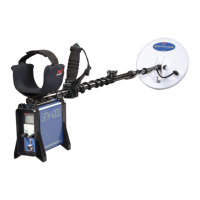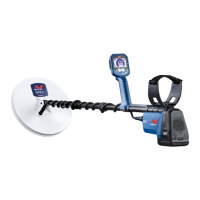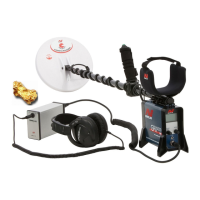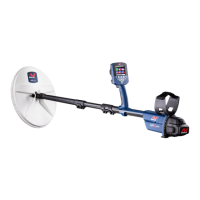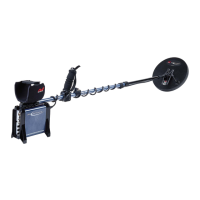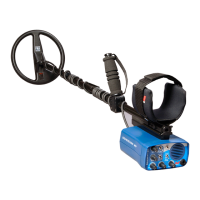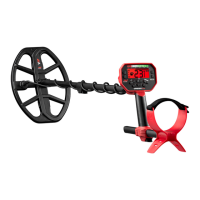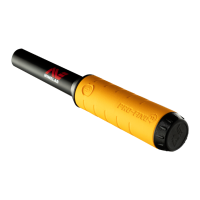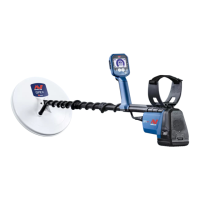

Do you have a question about the Minelab GPX6000 and is the answer not in the manual?
| Technology | GeoSense-PI |
|---|---|
| Weight | 2.1 kg (4.6 lbs) |
| Battery Type | Rechargeable Lithium-ion |
| Battery Life | Up to 8 hours |
| Ground Balance | Automatic and Manual |
| Display | LCD |
| Waterproof | Coil waterproof to 1 m (3 ft) |
| Audio Output | Built-in speaker, Bluetooth headphones |
| Search Coils | 11" Monoloop, 14" DD |
| Headphones | Wireless (Bluetooth) included |
| Search Modes | General |
| Interference Cancellation | Automatic EMI cancellation |
Step-by-step guide for quick detector setup and operation.
Recommended settings for initial use, optimal for most conditions.
Procedure to restore the detector to its original factory default settings.
Manages Bluetooth connection for wireless headphones and pairing.
Adjusts the screen backlight brightness levels.
Turns the detector on/off and performs a factory reset.
Controls the detector's sensitivity level for target detection.
Toggles between Normal and Difficult ground balancing modes.
Initiates noise cancellation or switches Double-D modes.
Adjusts the audio output volume level.
Trigger for initiating Quick-Trak Ground Balance.
Shows Bluetooth audio connection status for headphones.
Displays the selected Double-D mode (EMI or Conductive Ground Cancel).
Indicates the status of the detector's backlight.
Shows the currently selected Ground Type setting.
Indicates if the Noise Cancel process is active.
Shows whether wired or Bluetooth headphones are connected.
Alerts the user to coil or system errors.
Shows the current audio volume level.
Displays the current sensitivity setting.
Shows the remaining battery charge level.
Step-by-step guide for pairing Minelab ML 100 headphones with the GPX 6000.
General-purpose coil for most conditions, good depth and sensitivity.
Ideal for large areas and deep nuggets in less mineralised ground.
Best for high EMI or conductive soils, less sensitive than mono coils.
How to set the highest stable sensitivity for optimal performance.
Guide to Manual (Low/High) and Auto sensitivity levels.
Automatic and manual ground tracking for noisy conditions.
Detailed steps for conducting the Quick-Trak ground balance procedure.
Comparison of automatic and manually initiated ground balancing methods.
Steps for quiet ground: Quick-Trak, then Sensitivity adjustment.
Steps for conductive ground: Double-D coil, Quick-Trak, Sensitivity.
Steps for variable ground: Difficult Type, Quick-Trak, Sensitivity.
Apply recommended settings for advanced Mono coil detecting.
Swing coil to listen for noise and adjust sensitivity.
Use Noise Cancel to remove EMI-induced noise.
Lower sensitivity when EMI is the primary noise source.
Change to Double-D coil if Mono coil is too noisy due to EMI.
Choose EMI Cancel or Salt Cancel based on noise source.
Reduce sensitivity or power off if noise persists in Double-D mode.
Begin detecting when acceptable noise levels are achieved.
Steps to initiate the automatic noise cancellation process.
Techniques to diagnose noise from EMI, conductivity, or ground.
Discusses coil winding and when to use Double-D coils.
How Ground Type controls unwanted ground noise removal.
Guide to toggling and selecting Normal/Difficult Ground Type.
Comparison of Difficult vs. Normal ground types for different conditions.
How to switch between EMI Cancel and Conductive Ground Cancel.
Guidance on selecting EMI or Salt Cancel based on noise.
Use cases for EMI Cancel and Conductive Ground Cancel.
Explains error indicators and initial troubleshooting steps.
Detailed procedures for resolving coil and system errors.
Troubleshooting detector power on/off problems.
Steps to fix no sound with wired headphones.
Troubleshooting no sound with ML 100 headphones.
Resolving issues when ML 100 headphones fail to pair.
Fixing distortion or crackling in Bluetooth headphones.
How to fix detector shafts that slip or do not lock tightly.
Cleaning the built-in speaker for better sound quality.
Guidelines for washing, cleaning, and protecting the detector.
Legal information regarding the detector's intended use and limitations.
